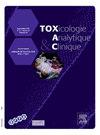High-resolution mass spectrometry for metabolomics
IF 1.7
Q4 TOXICOLOGY
引用次数: 0
Abstract
Objective
To elucidate the potential of high-resolution mass spectrometry (HRMS) in metabolomics, particularly within the field of toxicology.
Metabolomics refers to the simultaneous detection and (semi)-quantification of a large-scale of small molecules, commonly known as endogenous metabolites. Compared to other omics approaches, metabolomics correlates well with phenotype, providing an amplified and dynamic measure of changes resulting from processes involving the genome, transcriptome, proteome, and the environment. Through its ability to highlight changes in the overall metabolic profile rather than focusing on a single metabolite, metabolomics presents itself as a promising tool for elucidating physiopathological mechanisms or even identifying new biomarkers, including in the field of toxicology.
Methods
Metabolomic can follow either a targeted (hypothesis-driven) or an untargeted (hypothesis-generating) approach. Common technological tools for metabolomic data production are based on nuclear magnetic resonance spectroscopy and mass spectrometry, each with complementary properties regarding sensitivity and metabolome coverage. HRMS-based metabolomics is particularly powerful, as it offers a high sensitivity and accuracy, broad chemical coverage, and, above all, enhanced structural information, enabling better identification of unknown features. For these reasons, HRMS is especially well suited for untargeted metabolomic approaches.
Results
HRMS-based metabolomics shows significant potential to address unmet clinical needs in biological and forensic toxicology by confirming exposure, effects, and/or toxicity related to xenobiotics, and enhancing post-mortem interpretation in forensic cases. As a highly dynamic and rapidly evolving field, biological and forensic toxicology are constantly confronted with new challenges, such as the need to confirm acute drug consumption, extend detection windows, discriminate addiction from occasional consumers, improve post-mortem investigations (cause of death, post-mortem interval), provide unambiguous evidence of sports doping.
Discussion–conclusion
Although HRMS applications have been demonstrated in several research contexts, challenges remain before it can be fully implemented in routine forensic and clinical practice. Key obstacles include the technical complexity of data interpretation and bioinformatic workflows, along with a lack of standardized protocols.
代谢组学的高分辨率质谱分析
目的探讨高分辨率质谱法(HRMS)在代谢组学,特别是毒理学研究中的应用潜力。代谢组学是指同时检测和(半)定量大量小分子,通常被称为内源性代谢物。与其他组学方法相比,代谢组学与表型有很好的相关性,为基因组、转录组、蛋白质组和环境等过程产生的变化提供了放大和动态的测量。代谢组学能够突出整体代谢谱的变化,而不是专注于单一代谢物,因此在阐明生理病理机制甚至识别新的生物标志物(包括毒理学领域)方面,它是一种很有前途的工具。方法代谢组学可以采用靶向(假设驱动)或非靶向(假设生成)方法。代谢组数据生产的常用技术工具是基于核磁共振波谱和质谱,它们在灵敏度和代谢组覆盖范围方面具有互补特性。基于hrms的代谢组学特别强大,因为它提供了高灵敏度和准确性,广泛的化学覆盖,最重要的是,增强的结构信息,能够更好地识别未知特征。由于这些原因,HRMS特别适合于非靶向代谢组学方法。结果基于shrms的代谢组学通过确认外源药物的暴露、影响和/或毒性,以及加强法医案例的尸检解释,在解决生物学和法医毒理学未满足的临床需求方面显示出巨大的潜力。作为一个高度动态和快速发展的领域,生物和法医毒理学不断面临新的挑战,例如需要确认急性药物消耗,延长检测窗口,区分成瘾者和偶尔消费者,改进死后调查(死因,死后间隔),提供明确的体育兴奋剂证据。尽管HRMS的应用已经在一些研究背景下得到了证明,但在常规法医和临床实践中全面实施之前,仍然存在挑战。主要障碍包括数据解释和生物信息学工作流程的技术复杂性,以及缺乏标准化协议。
本文章由计算机程序翻译,如有差异,请以英文原文为准。
求助全文
约1分钟内获得全文
求助全文

 求助内容:
求助内容: 应助结果提醒方式:
应助结果提醒方式:


